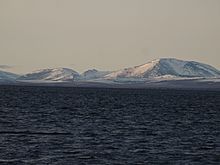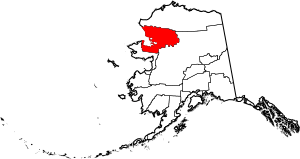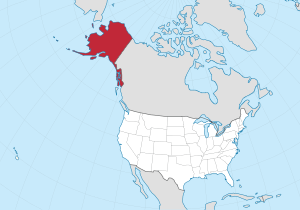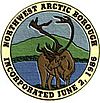Northwest Arctic Borough, Alaska facts for kids
Quick facts for kids
Northwest Arctic Borough
|
||
|---|---|---|

The Kotzebue Sound as seen from Cape Krusenstern National Monument.
|
||
|
||

Location within the U.S. state of Alaska
|
||
 Alaska's location within the U.S. |
||
| Country | ||
| State | ||
| Incorporated | June 2, 1986 | |
| Named for | Northwest and Arctic location | |
| Seat | Kotzebue | |
| Largest city | Kotzebue | |
| Area | ||
| • Total | 40,749 sq mi (105,540 km2) | |
| • Land | 35,573 sq mi (92,130 km2) | |
| • Water | 5,176 sq mi (13,410 km2) 12.7% | |
| Population
(2020)
|
||
| • Total | 7,423 | |
| • Density | 0.182164/sq mi (0.070334/km2) | |
| Time zone | UTC−9 (Alaska) | |
| • Summer (DST) | UTC−8 (ADT) | |
| Congressional district | At-large | |
Northwest Arctic Borough is a borough located in the U.S. state of Alaska. As of the 2020 census, the population was 7,793, up from 7,523 in 2010. The borough seat is Kotzebue. The borough was formed on June 2, 1986.
Contents
Geography
According to the U.S. Census Bureau, the borough has a total area of 40,749 square miles (105,540 km2), of which 35,573 square miles (92,130 km2) is land and 5,176 square miles (13,410 km2) (12.7%) is water. By land area, it is slightly larger than the state of Maine.
Its coastline is limited by the Chukchi Sea. The Kotzebue Sound, a significant wildlife area, is a prominent water body within the Northwest Arctic Borough. The largest polar bear sighted in history, a male weighing 2,209 pounds (1,002 kg), was sighted at Kotzebue Sound.
Adjacent boroughs and census areas
- North Slope Borough, Alaska - north
- Yukon-Koyukuk Census Area, Alaska - east
- Nome Census Area, Alaska - south
National protected areas
- Alaska Maritime National Wildlife Refuge (part of the Chukchi Sea unit)
- Chamisso Wilderness
- Bering Land Bridge National Preserve (part)
- Cape Krusenstern National Monument
- Gates of the Arctic National Park and Preserve (part)
- Gates of the Arctic Wilderness (part)
- Kobuk Valley National Park
- Kobuk Valley Wilderness
- Koyukuk National Wildlife Refuge (part)
- Noatak National Preserve (part)
- Noatak Wilderness (part)
- Selawik National Wildlife Refuge (part)
- Selawik Wilderness
Demographics
| Historical population | |||
|---|---|---|---|
| Census | Pop. | %± | |
| 1960 | 3,560 | — | |
| 1970 | 4,434 | 24.6% | |
| 1980 | 4,831 | 9.0% | |
| 1990 | 6,113 | 26.5% | |
| 2000 | 7,208 | 17.9% | |
| 2010 | 7,523 | 4.4% | |
| 2020 | 7,793 | 3.6% | |
| 2023 (est.) | 7,361 | −2.2% | |
| U.S. Decennial Census 1790-1960 1900-1990 1990-2000 2010-2020 |
|||
At the 2000 census, there were 7,208 people, 1,780 households and 1,404 families residing in the borough. The population density was 0.18 per square mile (0.069/km2). There were 2,540 housing units at an average density of 0 per square mile (0/km2). The racial makeup of the borough was 12.32% White, 0.21% Black or African American, 82.46% Native American, 0.89% Asian, 0.06% Pacific Islander, 0.36% from other races, and 3.70% from two or more races. 0.79% of the population were Hispanic or Latino of any race. 40.00% reported speaking Inupiat or "Eskimo" at home.
There were 1,780 households, of which 55.20% had children under the age of 18 living with them, 47.90% were married couples living together, 19.70% had a female householder with no husband present, and 21.10% were non-families. 16.60% of all households were made up of individuals, and 2.10% had someone living alone who was 65 years of age or older. The average household size was 3.87 and the average family size was 4.36.
Age distribution was 41.50% under the age of 18, 10.00% from 18 to 24, 28.10% from 25 to 44, 15.50% from 45 to 64, and 5.00% who were 65 years of age or older. The median age was 24 years. For every 100 females, there were 114.50 males. For every 100 females age 18 and over, there were 120.70 males.
2020 Census
| Race | Percentage of Population |
|---|---|
| White | 13.99% |
| Black or African American | 1.72% |
| American Indian or Alaska Native | 88.13% |
| Asian | 1.45% |
| Native Hawaiian and Other Pacific Islander | 0.46% |
| Some other race | 0.92% |
Communities
Cities
Census-designated places
See also
 In Spanish: Borough de Northwest Arctic para niños
In Spanish: Borough de Northwest Arctic para niños


